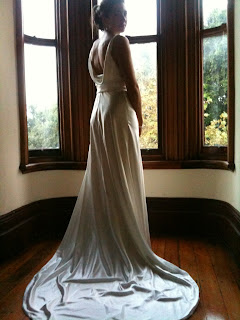Third instalment...
This week is a very fun wedding dress conversion.
One day the client, Kathryn, came into the shop with her Mum's wedding dress from the 1970's. It was a sweet, but very '70's dress with a lace high - necked bodice and sleeves, and polyester A-line skirt. She wanted to wear it to honour her mum, and to hopefully get an original dress for her own wedding.
 |
| 1970's wedding dress |
 |
| Back |
Kathryn said she wanted to transform it into a modern dress for her beach wedding. She wanted a strapless, boned bodice with the lace extended down to the hipline, and a slimmer skirt line. I suggested a a silk lining and possibly an over-lay on the skirt in order the cover the polyester. For her budget I needed to "retro-fit", not deconstruct, then re-construct the entire dress.
So the three "S's" for Kathryn were;
1. Setting: Beach
2. Season: Autumn
3. Style: Contemporary
We integrated these through the modern strapless design, and the softness of the overlay, which created a more organic, flowing silhouette, to suit the beach setting.
First I cut back the bodice and took it in to fit Kathryn's shape, marking the new design lines around the hip and necklines, shown below.
Then, onto the dress, I draped the corset shape in calico, extending from the new neckline to the hip line. I then transferred this and made the corset pattern in paper.
Then I made the corset "insides'' from Shapewell and polyester boning, to sit inside the shell of the dress. There was also a silk lining, from the same (tightened) pattern.
Then we came to a fork in the (design) roads; once I had a basic re-modelled dress, I started playing with how to adapt these features Kathryn wanted into an original, and appropriate dress.
There were two main directions:

1. As Kathryn had directed, lengthening the lace bodice to the hips. As she is a petite bride, I was concerned about the 1:1 proportion of this design, as it could make her torso look too long. In other words, she would be half torso/half skirt, which is not a great ratio.
I added the overlay here to soften the sad old polyester skirt, and added a silk petticoat with a duster hem (ruffled).
2. The second option was this more classical, empire-line design, below. This worked with the original line of the lace, and had a more flowing look to the skirt, which I felt suited her setting better, as well as her figure.
Ultimately, Kathryn and I devised a combination of the two.
She wanted a fitted form over her tummy, and hips, and felt the softer design wouldn't suit her, so we went with the longer lace to the hips. But I added a belt to raise her waist visually, and we draped the chiffon over her shoulder and across the skirt to get some dynamism into the silhouette, with drape and asymmetry.
 |
| Finished gown, with lace to the hip, built in corset, satin belt and chiffon draped skirt. |
 |
| Back view |
 |
| Draped side view |
 |
| Front; sweetheart neckline, asymmetrical strap and skirt drape. |
Again, Kathryn had a great time in her dress, and loved that it was handmade for the occasion. It was a very personal and very cost effective way to create an original wedding dress, and I had a great time doing it. Thank you Kathryn, for thinking outside the box!
Next week, a wedding dress inspired by red carpet glamour.



























